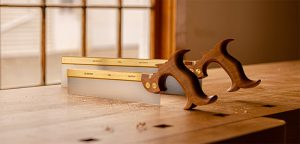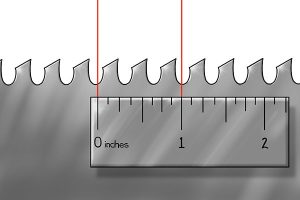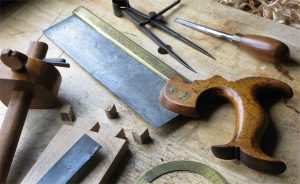Before diving into the specifics of the Bad Axe dovetail saw review, it’s worth understanding the company behind this exceptional tool. Bad Axe Tool Works is an American company renowned for producing some of the finest hand saws available today. Founded by Mark Harrell, a master saw-maker with a passion for traditional craftsmanship, Bad Axe has built a reputation for creating tools that blend historical design principles with modern manufacturing precision.
The company’s philosophy centers on the belief that well-made hand tools not only produce superior results but also enhance the overall woodworking experience. This ethos is reflected in their dovetail saw, which represents the perfect marriage of form and function.
What Makes a Dovetail Saw Essential?
For those new to woodworking, a dovetail saw is a specialized backsaw designed for creating fine, precise joints, particularly dovetail joints – hence the name. These joints are celebrated for their mechanical strength and aesthetic appeal, making them a hallmark of quality craftsmanship.
Unlike larger saws, a dovetail saw features a relatively short blade with fine teeth, allowing woodworkers to make accurate, controlled cuts. The rigidity provided by a reinforced back ensures straight cuts, which is essential for creating tight-fitting joints.
Bad Axe Dovetail Saw Review: Specifications at a Glance
The Bad Axe dovetail saw comes in several configurations, but its most popular model features:
- Blade Length: 10 inches.
- Plate Thickness: 0.020 inches.
- TPI (Teeth Per Inch): 15 points per inch (approximately 16 TPI).
- Tooth Configuration: Rip pattern.
- Blade Material: Swedish spring steel.
- Back Material: Folded brass.
- Handle Material: Curly maple or cherry (customizable).
- Overall Weight: Approximately 0.75 pounds.
- Handedness: Available for right or left-handed users.
Design and Build Quality: Where Excellence Meets Artistry
One of the first things you’ll notice about the Bad Axe dovetail saw is its exceptional build quality. The folded brass back not only provides rigidity for precise cutting but also adds a satisfying heft that helps the saw track smoothly through the wood.
The blade itself is crafted from Swedish spring steel, known for its excellent balance of hardness and flexibility. This material choice allows the saw to hold a sharp edge while remaining resistant to bending or kinking during use.
What truly sets the Bad Axe dovetail saw apart, however, is the attention to detail in its design. The teeth are precision-ground and hand-sharpened, with each one individually inspected to ensure consistency. The rip pattern tooth configuration is specifically designed for cutting along the grain, perfect for dovetail joints, where most cuts are made with the wood’s grain.
The handle deserves special mention as well. Available in beautiful curly maple or cherry, each handle is shaped to fit comfortably in the hand, reducing fatigue during extended use. The ergonomic design considers the natural grip position, allowing for precise control without strain.
Performance: Cutting Through the Competition
In practical use, the Bad Axe dovetail saw truly shines. The sharp, precisely set teeth bite into wood effortlessly, requiring minimal pressure to start a cut. Once underway, the saw tracks straight and true, leaving a clean, smooth surface that often requires no additional finishing.
The balance of the saw feels natural in the hand, with the weight distribution encouraging a smooth, rhythmic cutting motion. Whether you’re making full-depth cuts in hardwood or more delicate trimming operations, the Bad Axe responds with predictable precision.
One aspect that particularly impressed us during testing was the saw’s versatility. While designed primarily for dovetail joints, it performs admirably on other fine cutting tasks, including tenon shoulders, small cross-cuts, and even some delicate inlay work.
Ergonomics and User Experience
Woodworking is as much about the experience as it is about the result, and the Bad Axe dovetail saw excels in making the process enjoyable. The handle’s shape and finish feel comfortable even after hours of use, and the saw’s overall balance reduces the effort required for precise cutting.
Unlike many mass-produced saws that can feel harsh or “chattery” during use, the Bad Axe cuts with a smooth, almost melodic rhythm that many users find satisfying. This feedback is not just pleasant – it also helps the craftsman develop a feel for the cut, resulting in better control and more consistent results.
Comparison with Other Dovetail Saws on the Market
To truly appreciate the Bad Axe dovetail saw, it’s helpful to compare it with other options available:
Bad Axe vs. Lie-Nielsen
Lie-Nielsen is another respected name in premium hand tools, and their dovetail saw is certainly a quality instrument. However, many users find that the Bad Axe offers a more aggressive cut and better balance. The Bad Axe also provides more customization options, including the choice of wood for the handle and specific tooth configurations.
Bad Axe vs. Veritas
Veritas dovetail saws are known for their innovative designs and typically come at a lower price point than Bad Axe. While Veritas saws are certainly capable, they generally don’t match the Bad Axe in terms of material quality or cutting precision. The Bad Axe’s brass back and Swedish steel blade give it an edge in both performance and durability.
Bad Axe vs. Vintage Saws
Many woodworkers swear by vintage dovetail saws from manufacturers like Disston or Simonds. While these antique tools can certainly perform well, they often require restoration and may not offer the same level of precision as a modern Bad Axe. Additionally, the Bad Axe comes with the advantage of modern metallurgy and manufacturing consistency.
Pros
- Exceptional build quality with premium materials.
- Precise, smooth cutting action.
- Beautiful aesthetics that make it a display-worthy tool.
- Customizable options to suit individual preferences.
- Made in the USA with attention to detail.
- Excellent balance and ergonomics.
- Versatile performance across various fine cutting tasks.
Cons
- Premium price point (though justified by the quality).
- May require a short adjustment period for those accustomed to other saws.
- Limited availability due to small-batch production.
Who Is the Bad Axe Dovetail Saw Best Suited For?
While any woodworker could benefit from using a high-quality tool like the Bad Axe dovetail saw, it’s particularly well-suited for:
- Professional woodworkers who demand the best tools for their craft.
- Serious hobbyists who appreciate fine tools and want to elevate their work.
- Hand tool enthusiasts who value traditional craftsmanship.
- Woodworkers specializing in joinery-intensive projects like cabinetry and fine furniture.
For beginners, the Bad Axe might represent a significant investment. Still, those committed to developing their hand tool skills will find it a worthy purchase that can grow with them as their abilities improve.
Maintenance and Care Tips
To keep your Bad Axe dovetail saw performing at its best:
- Keep it clean: Wipe the blade after each use to remove moisture and wood residue.
- Protect the teeth: Use a blade guard or store the saw in a way that prevents the teeth from contacting other tools.
- Oil the blade: A light coat of camellia oil or similar rust preventative will protect the steel between uses.
- Sharpen when needed: While the Bad Axe holds an edge well, eventually it will need sharpening. Either learn to do it yourself or send it back to Bad Axe for their professional sharpening service.
- Store properly: Keep the saw in a dry place, preferably hanging or in a tool chest, where it won’t be subjected to temperature and humidity fluctuations.
Value for Money Analysis
With a price point typically ranging from $300 to $400, depending on configuration, the Bad Axe dovetail saw represents a significant investment. However, when viewed as a lifetime tool that will likely outlast its owner, the value proposition becomes much clearer.
Consider that this saw can perform tasks that might otherwise require power tools, saving space in your workshop and providing a more enjoyable woodworking experience. The precision it offers can also reduce material waste and eliminate the need for time-consuming corrections.
When amortized over years or even decades of use, the cost per use becomes minimal, especially when factoring in the superior results and enhanced enjoyment of the woodworking process.
Conclusion and Final Recommendations
After extensive testing and consideration, it’s clear that the Bad Axe dovetail saw represents the pinnacle of what a modern hand saw can be. It combines historical design principles with contemporary manufacturing precision to create a tool that not only performs exceptionally but also enhances the woodworking experience.
For woodworkers who demand the best and are willing to invest in tools that will serve them for a lifetime, the Bad Axe dovetail saw comes with our highest recommendation. While the initial cost may be substantial, the performance, durability, and sheer pleasure of using this fine instrument make it a worthwhile investment for anyone serious about the craft of woodworking.
Whether you’re creating intricate dovetail joints for a display cabinet or simply enjoying the meditative process of cutting wood by hand, the Bad Axe dovetail saw delivers an experience that few other tools can match. It’s more than just a saw – it’s a testament to the enduring value of craftsmanship in an age of mass production.





